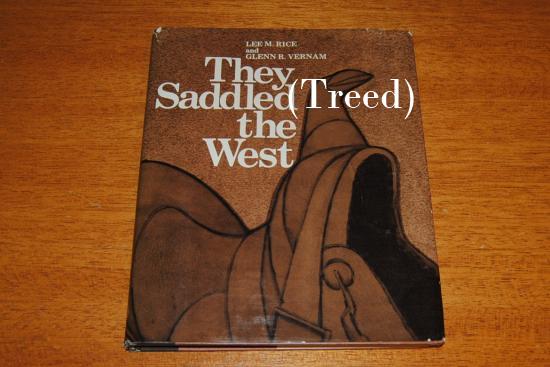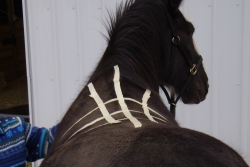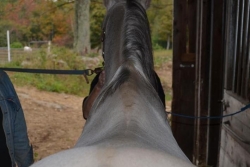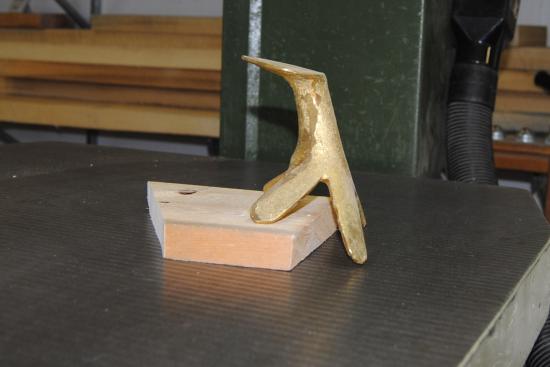They Saddle (Treed) the West
We are no longer building saddle trees, but we have two videos about how Western saddles fit horses available on our westernsaddlefit.com website.

Like I said in my last post, I was really interested in the history of saddle trees and saddle tree makers as I read through this book. I found some information on them, though not near as much as I would have liked. And I discovered that, despite how "the golden age of cowboys" is often portrayed, there really has been improvements in saddle trees since then.
Saddle fit was an issue even back then
There is an interesting quotation on page 75 at the beginning of the chapter on saddle trees. After talking about the great reputation of Main and Winchester, one of the older saddle companies, they quote from a diary of a man who had bought some. "A further notation in December 1879 gives us some idea of what the trees in these saddles were like, after three years of hard use on the cow ranges of Boxelder and Chugwater Creeks in Wyoming: "December 14, at Bordeaux, Washed and greased horses' backs. December 16, Doing little except taking care of ranch, washing sore-backed ponies, etc." Although the old familiar fault was ever present in the Main and Winchester saddles, it was equally true of their competitors. Despite the good quality of saddles, the defects in trees had not as yet been conquered." So saddle trees and how they worked on horses were just as much a discussion point back then as they are now.
The tree is still the foundation of the saddle
Throughout the book, there are occasional mentions of tree makers, often with sentences like this attached to them: "His belief was that a fully successful saddle could by achieved only by building it on a properly constructed tree." So that much hasn't changed over the past 200 years. Good saddle makers still recognize that the tree is the foundation for the saddle and if it isn't right, it doesn't matter how pretty you make it. It still will not be a good saddle.
Visalia, California tree makers
Some of the names mentioned are not very well known, though the names of the companies they built trees for are. The quote in the last paragraph was talking about tree maker Tony Lasdema, and was followed by this sentence: "Thus his craftsmanship was largely responsible for the popularity of Salazar saddles." The T. Salazar company was well established in Visalia, California when Ricardo Mattle (with a thingy over the e and later spelled Mattley) and Juan Martarel moved there to set up shop. Mattle "had already made some improvements on the Mexican saddle tree then in common use. His contention was the certain modifications of the tree would lead toward the desired results. The two men put their heads together, eventually coming up with what was to later develop into the famous Visalia tree."
But it took more heads than that to really get the Visalia tree developed. Henry Gust Shuham and DE Walker merged with the company, and still they were playing second fiddle to T. Salazar's company. So they enlisted Jose Rodriguez, who "viewed improved trees as the primary secret of superior saddles." He had already developed a successful tree, and his input combined with Mattle's came up with the Visalia tree that set up the Visalia Stock Saddle company to be the success that it was.
A few tree makers they mention - and don't
A lot of people know of Frank Meanea, but they don't know of Theodore Meanea who built Frank's trees throughout the lifetime of his company. The chapter on Hamleys in Pendleton doesn't even mention the name of Walt Youngman, their long time tree maker. He was the one who would have made the first Wade tree for Tom Dorrance, so his name is probably better known now than most tree makers of the past.
The chapter on trees is devoted more to chronicling the changes in materials and design in trees over time than to the people who built them. They briefly mention Ringhoffer Brothers of Walla Walla, Washington from the late 1800s and early 1900s, and Ray Holes from the early 1950s. But they spend five paragraphs talking about Aleck Taylor and his brother Geroge who made up the Taylor Brothers. This name is still used today as a name for a fork style (a Taylor fork), and for a style of cantle (a Taylor cantle).
The Taylor Brothers
The Taylor brothers were ranchers primarily and it was just the two of them working in their kitchen, basically in the winters, building trees when the outside work was done. They apparently used their own beef hides to make their rawhide as well. I checked our records, and we go through 32 to 34 hides a year. So either they sold a lot of beef, or they didn't make large numbers of trees. The latter is probably true as they only sold their trees to a few California saddle makers. But despite the limited numbers, the trees apparently became known nation wide and saddles with these trees commanded a premium price. We have heard, though I couldn't tell you where and can't confirm the truth, that a Taylor tree cost $10 back when the full saddle cost $40. (I can't say there are a whole lot of $2400 saddles being sold with our $600 trees in there. The tree/saddle price ratio is a little different today...)
There are a few interesting sentences about the Taylor Brothers' guarantee. "It was an old axe out by the woodpile. Any owner of a Taylor tree that hurt a horse's back was privileged to watch the tree being broken up before his eyes with the famous axe. All the brothers asked was to be told what was wrong. Once convinced that the vaquero was right, the latter could rest assured that the defective tree would never hurt another horse." So I wondered if we could give the same guarantee on our trees. We have always said that we stand behind our trees for workmanship and fit. And if there were ever to be a truly defective tree come back, absolutely, it would be replaced. (In fact, we have replaced trees in the past that turned out to be soring horses because of uneven riggings, but that is another story...) But the Taylor Brothers' trees were being used in a relatively small geographical area and in an era and area when horses were much more similar in back size and shape than what they are now, while our trees are shipped all over North America and some even to Europe, and for a far larger variety of horse sizes and shapes.


So if the tree for either of these horses were used on the other, it would probably sore them, but it shouldn't be punishable by the axe, because there wouldn't be fault in the tree. The fault would be in using such an inappropriate tree on the horse. So no, we won't put out the same blanket guarantee.
History of the materials used
Reading through the differences in materials over the years was interesting, as a few things have gone full circle. The original trees used to be straight hardwood from whatever local hardwood trees were available. The Taylor trees were made of willow (I wonder where they got willow wood that wide) which made them lighter. It was at the turn of the 20th century that they started to use pine instead. According to Rice, "The later change to white pine gave lighter weight, greater resilience and eliminated the warping problem." I'm not so sure about the last phrase, depending on which type of wood they are comparing to. Today's production trees are still primarily made of various types of pine (there are exceptions), but most hand made tree makers use a variety of woods, often fir, yellow poplar and often some kind of hardwood in the fork as well as some pine. So that has come back around again.
Originally, there were no laminations in the wood. It was when they started to use pine that the idea of making both fork and cantle of two pieces mortised down the center started to come into vogue. Anyone who has taken apart an old tree and seen how the horn was the only thing still holding the fork together can see the problems with this method. However, they must have held together well enough for long enough, and the advantages over the heavier straight hardwood trees must have been great enough that trees kept being built that way. Toward the end of the chapter, they talk about Ray Hole's "revolutionary saddle tree... made of a fork of laminated wood... (which) allows it to be cut much thinner in the gullet." I don't know of any of today's' trees which are mortised down the center, and even some production trees have a lamination in their all-pine forks. But most hand made tree makers follow the basic idea Ray Holes had of multiple laminations in their forks and even the cantles. (Please see our Construction Materials page for how we build our trees.)
They also talk about the "steel" fork of the early 1900's, probably made of cast iron which were hollow shells. They didn't last long. There were aluminum trees in the 1940's. They didn't last long either. And the chapter ends with "What next? Who knows? Plastic, maybe, or some made of an as yet unheard-of material. but we may be sure that changes in the cattle industry, coupled with the ingenuity of man, will produce something radically different from the old wood and rawhide saddle foundations that have served the Western cowmen for a century and a half." Well, there are a lot of different synthetic saddle trees on the market now, but the tried and true wood and rawhide tree is still around almost forty years after this book was written and we sure don't see them disappearing anytime soon.
History on horns
Another thing that has come back around again is the horn type. Horns were originally all wood, with the fork being made of a natural fork in the tree, the trunk being the horn and the forks attaching to the bars. The necks on these forks often broke, which was a major problem. "By the 1800's, most saddle shops were carrying a line of repair horns for repairing dehorned saddles at small cost." They were metal horns with a hollow center that could be screwed down over the broken stump of the old wood horn.

This explains why the old horns were larger at the base and got smaller towards the cap, which is backwards to what you want for roping. You want your dallies to go to the base of the horn, closer to the horse's back, and not increase the torque on the horse by going to the top of the horn. But when you understand that the base had to fit over an old broken wood horn, it makes sense. And it took a while for horn makers to change the shape, even when using metal horns on brand new trees. The horn pictured above is a style Herb Bork copied from an old tree. He calls it the Old Timer, and it sure fits nice on slick forks. It shows the shape metal horns had for a long time, though it is narrower at the bottom than a lot of the old ones.
According to this book, by the 1890's, steel or iron horns were on almost all trees. They also mention nickel and bronze, but don't talk about aluminum which probably was introduced, or at least became common, after the book was written. And despite the fact that the original Wade tree with a wood post horn was built over 35 years before this book was published, there is no mention of modern wooden horns. This is probably because they were not common until into the 80's, and not popular until later than that. So once again, things have gone full circle, from wood, to metal, to well over half the trees we build being wood post horns again. (Of course, this probably has to do with our clientele being a high proportion of Wade users, but still...)
More recent history
There could be a whole other chapter or more added into this history covering saddles and trees in the years since it has been published. There have still been innovators who have changed the way the saddle making industry works. Don King and others who created/perfected the Sheridan style of carving. The TCAA and its influence in getting Western gear seen as an art form. Functionally, there have been different ideas in how seats should be shaped to position the rider differently, from the "equitation seats" of the 70's to the super flat seats in cutters for a while to the idea of a "balanced seat" and how it helps a rider maintain a more upright position. Hamley hangers and the other ideas on how stirrups can be attached to saddles is one of the design changes that have come - and gone - in the saddle world.
Tree wise, there have been the different branches of the Severe family who have really influenced today's tree makers. Dale Harwood and his influence on both saddle and tree making would be mentioned. The Wade tree, how it came about and how it has risen in popularity is another story in itself. And even today, something like the Dennis Lane equine back measuring system, coming from an innovative tree and saddle maker from Australia, has the potential to make a difference in the tree making world, not to mention the potential for the whole saddle industry. Only time will tell how it works out.
The more things change...
So overall, this has been a very interesting read - again. It shows a few things: That although some things change, some things come full circle but the basics stay the same. That making a tree that fits a horse well has always been key to making good saddle. That different areas and different people will always have different opinions, but there is more than one way to build a good saddle. That there are always innovators with new ideas and, if they are good ones, they catch on. If they aren't, we either don't know about them or they end up as a brief mention of something that was tried and failed. But that overall, the desire of good, truly custom saddle and tree makers has always been to make the best functioning, the best quality, and the best looking saddles that they could. And that hasn't changed one iota...
